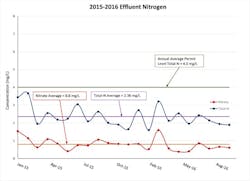Improving the Health of Long Island Sound
It has long been known that nitrogen discharges into Long Island Sound are a key factor in its water quality. State Pollution Discharge Elimination System (SPDES) limits issued in 2005 and a negotiated order of consent would require an upgrade to the New Rochelle wastewater treatment plant (WWTP) to remove nitrogen from its discharge. On average, the mass-based nitrogen requirement would require the facility to meet a total nitrogen (TN) discharge of 4.0 mg/L or less at design flow. In addition, tighter restrictions on carbonaceous biochemical oxygen demand (CBOD) and total suspended solids (TSS) would be included in the new permit. Land availability in New York is scarce, so the solution needed to fit on the existing site. Savin Engineers PC—the client’s engineer—evaluated dozens of technologies to determine the preferred solution, including pilot scale testing. At the conclusion of the evaluation phase, a competitive life-cycle-based procurement was bid and the Veolia Biostyr biologically active filter (BAF) technology was selected as the preferred alternative due to its compact footprint and proven ability to remove nitrogen.
The Solution
Biostyr is a high-rate biological system for treating wastewater that offers full treatment capabilities for biochemical oxygen demand (BOD), TN and TSS removal in a single process, in 10% of the footprint of other technologies. The system utilizes multiple treatment cells operating in parallel to biologically treat and simultaneously filter the wastewater, producing an effluent free of contaminants and solids. Biological growth occurs on a fixed bed of Biostyrene media, which is contained within each cell and not exposed to the atmosphere. Flow enters at the bottom of each cell, and clean effluent collects at the top of each cell. This makes for a clean installation that is suitable for facilities with nearby communities, such as urban, densely populated areas.
Process Description
To meet the SPDES permit requirements of this facility, Veolia designed a Biostyr system containing two distinct stages of operation. The first stage is fully aerobic and targets complete nitrification to convert incoming ammonia into nitrate. This stage consists of 12 parallel cells, each with a footprint of 940 sq ft. The second stage is anoxic in the lower portion of the Biostyrene biological filter bed to facilitate denitrification of the incoming nitrates. Methanol is fed to the influent of this stage to serve as a carbon source for the microorganisms, as the influent to this stage contains very little BOD. To protect against increased BOD levels in the effluent due to unused methanol, the second-stage cells include an aeration grid within the filter media to allow fully aerobic operation of only the uppermost layer of media. The system was designed to meet future flow needs of up to a 31 million-gal-per-day (mgd) average and a 61.5-mgd peak with guaranteed effluent nitrogen performance.
[Visit Kruger's W&WD Storefront]
In addition to the Biostyr system, Veolia provided an upgrade to the existing pure-oxygen activated sludge system. This upgrade to the Oases pure oxygen system included new oxygen supply control equipment, new instrumentation for monitoring oxygen levels, and new aerator and mixer equipment. This system provides improved CBOD removal and more stable influent to the Biostyr process.
Results
The New Rochelle WWTP has been operational since late 2014 and has been a success, reducing the plant TN discharge from 2,000 lb per day in 2014 to 200 lb per day in 2015. Summer and winter performance tests were completed in 2015 to fully demonstrate the system’s capabilities, and exceptional nitrogen removal has continued throughout 2016. The Biostyr system is allowing Westchester County to improve the health of Long Island Sound.


